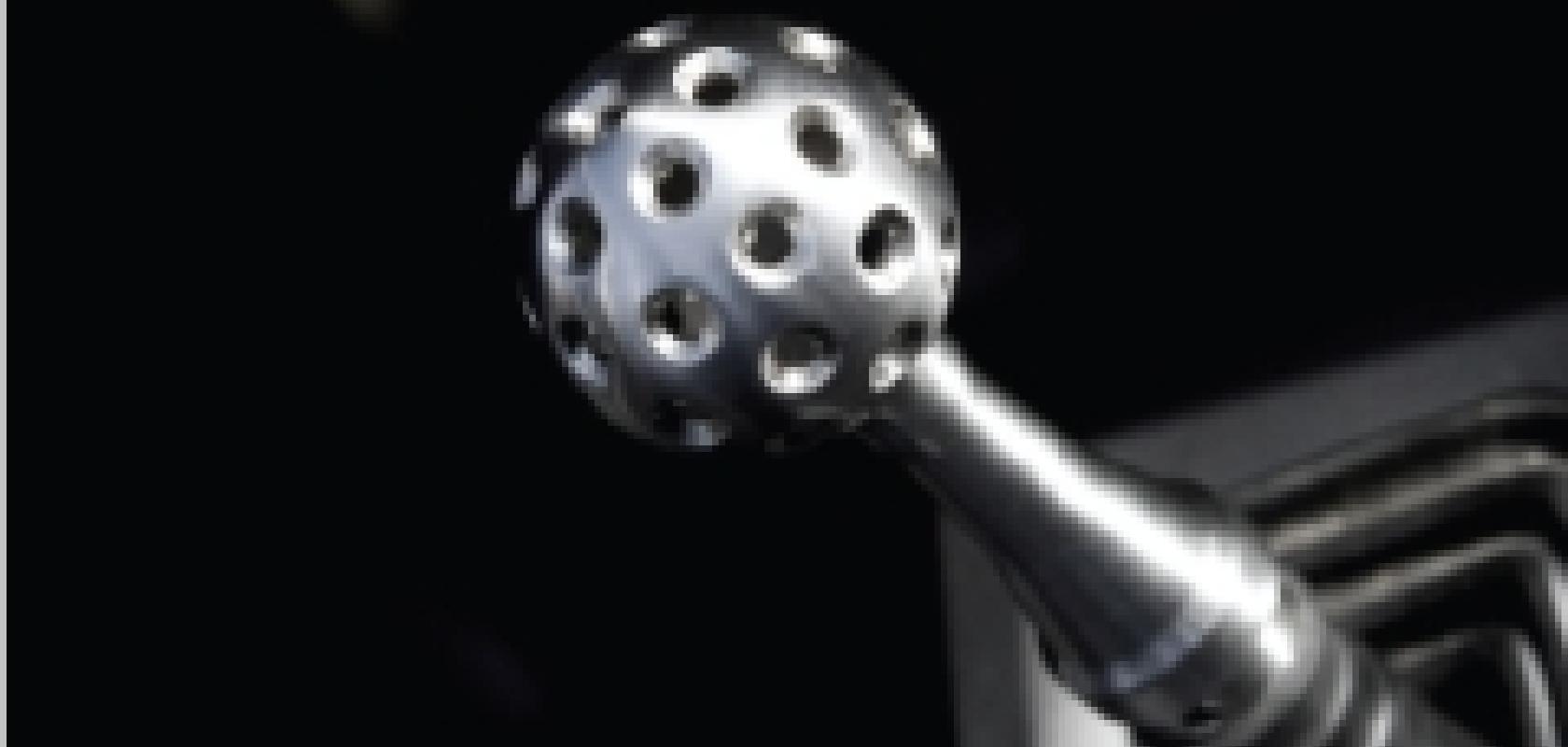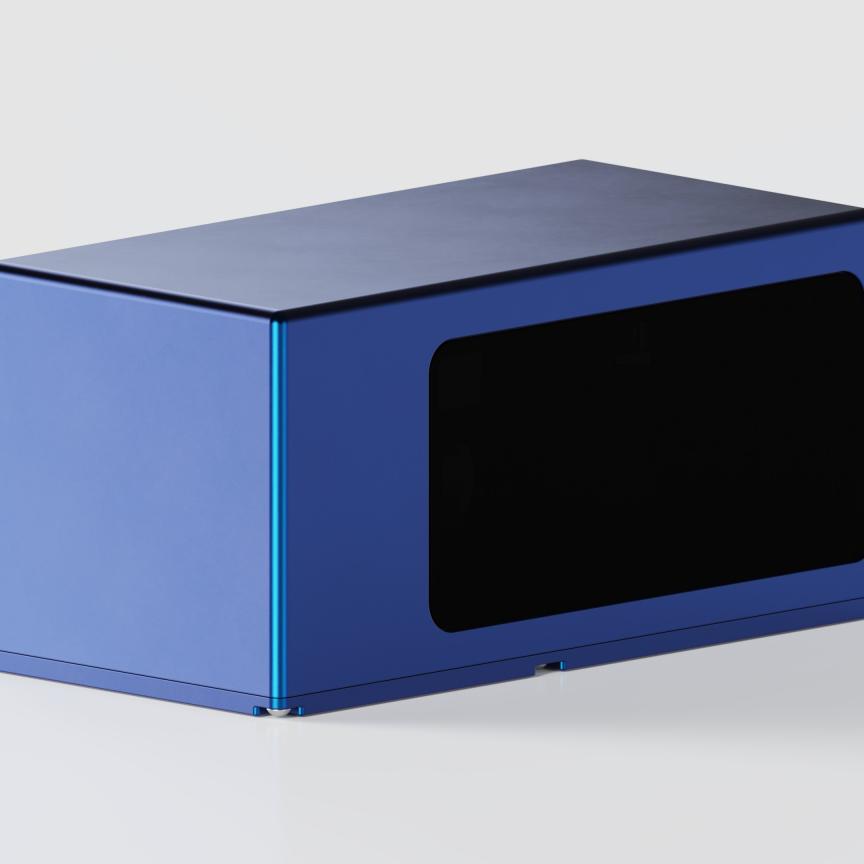The automotive sector has always been a significant market for photonics, and the diversity of applications now in evidence suggests that this is likely to be the case for some time to come.
One of the more unusual applications involves the process of laser sintering, which enables fine and delicate objects to be created from highly complex and intricate designs.
Volkswagen turned to direct metal laser sintering from EOS to help create a unique stainless steel gear lever knob for a special oneoff version of its two-seat, three-wheel GX3 model for display at the Los Angeles Auto Show. Volkswagen North America’s chief designer Derek Jenkins wanted something extraordinary to crown the vehicle design, so he and his team set about putting a twist on the VW Golf GTI’s golf ball-shaped gear lever knob (pictured above). The team conceived a hollow, lightweight version of the original design, and wanted a metallic finish that matched the trim and accents of the interior cockpit design.
Using direct metal laser sintering, the 17-4 stainless steel knob was made on an EOS M 270 system, after alternative methods, such as CNC machining, were rejected as being unable to fulfil the design. Volkswagen then turned the gear lever knob on a lathe and tapped a hole for a set screw. Jenkins says: ‘I was amazed how well it machined. It was fully dense, with the properties of billet material.’
Jenkins believes that the technology has helped free his design team’s creativity. ‘Previously, our designs were constrained by what traditional manufacturing technologies could produce,’ he says. ‘With this technology, will anyone be injection-moulding parts 10 years from now?’
He acknowledges that large-scale production units will still call on injection-moulding for the time being, but believes that the industry is moving towards ‘e-manufacturing’ – the fast, flexible and cost-efficient delivery of designs directly from CAD data.
This type of rapid prototyping is also being used by the Williams Formula 1 team, again using EOS technology. Back in 2005, Williams F1 invested in laser sintering at its headquarters in Grove, Oxfordshire, UK, to make prototypes quickly from plastic powders to test in a wind tunnel. Now, however, the team is using the technology to manufacture parts for full-size car mock-ups, as well as for the team’s test and race cars. Richard Brady, module leader in the digital manufacturing department at Williams F1, says:
‘Before we started laser sintering components, we frequently had to remake stereolithography components in our mock-ups, as repeated handling often caused them to break. By contrast, we have not had a single mechanical failure of any component we have made by laser sintering. They are much tougher and more durable, and are rapidly replacing parts made by other techniques.’
The 2006 FW28 model of the Williams F1 car featured most of the engine parts and the entire gearbox (apart from the main casing) produced on the EOS P 385 machines.
Laser sintering from EOS was used to create a unique gear know for VW.
‘Parts of the body and internals, like electrical wiring looms, can receive heavy handling by engineers, but the laser sintered parts stand up well,’ says Brady. ‘There has also been a big improvement in the quality and appearance of the mock-up, with the laser sintered parts fitting together perfectly nearly every time, saving time previously wasted modifying components to fit.’ Brady is clearly another fan of the opportunities created by laser sintering. ‘I predict it will make further inroads into conventional production techniques. The only limit is one’s imagination; if you can model it in CAD, you can make it, and the resulting laser-sintered parts are very robust and usable in a host of demanding applications.’
Welding
A more conventional use of photonics in the automotive sector is lasers for welding. In the automotive industry, there are myriad diverse applications for lasers with output power in the tens and hundreds of watts range. One of the largest of these applications is the use of direct diode lasers for welding plastics. According to Sri Venkat, director of marketing at Coherent, the reliability, simplicity, versatility, low cost, and fibre-coupled convenience of these lasers have made laser welding an attractive bonding method, compared to earlier techniques such as thermal adhesives and ultrasonic welding. Coherent supplies a wide variety of both fibre-coupled and free-space diode laser modules to the automotive industry, ranging from 30W up to the multi-kilowatt level, and the company’s low power (30-200W) fibre array packages and turnkey systems (FAPs and FAP systems) are now used extensively for these plastic welding applications.
Venkat notes that traditional bonding technologies are limited to flat surfaces only, whereas diode lasers can easily accommodate both flat and highly contoured surfaces, by using low-cost robotics to move the part or beam in three-dimensions.And since the target seam is typically 2-3mm wide, physical registration is normally sufficient, eliminating machine vision alignment and minimising process costs.
These applications often use transmission welding; the laser penetrates through a transmissive plastic part before being absorbed by the second part. Heat generated at the interface by this absorption serves to melt a thin layer of both materials. Ideally, this requires 99 per cent transmission by the front surface material and 99 per cent absorption by the second material. This is a perfect scenario for headlamp/tail lamp covers for example, where the cover is typically transparent ABS and the fixture is opaque PMMA. In other automotive applications where both surfaces have to be ABS, light absorbing additives are incorporated in the ABS to enable laser welding.
Headlamp covers are normally bonded with a lap weld configuration, typically using 30-50W of laser power. A key requirement here is to avoid any air gaps that might allow moisture or rain to enter the lamp fixture. But the moulded mating surfaces are rarely perfectly flat. So either the lamp fixture is clamped in some way, or the fibre umbilical that delivers the laser power is terminated in a rigid probe with a tough ball lens designed for direct contact. This is then pressed down on the plastic parts as the laser power is applied, ensuring contact between the surfaces.
Another of the many plastic welding applications involves ‘smart’ ignition keys. These incorporate a small PCB (printed circuit board) encapsulated within an outer plastic casing. Initially, this casing was sealed using ultrasonic welding, but this could cause solder joints in the PCB to weaken leading to premature failure. In response, all manufacturers have now switched to laser welding to avoid this potential problem. Certain techniques are particularly appropriate to the demands of automotive production, such as the beam deflection system from Scanlab. Andreas Engelmeyer, responsible for technical sales, says: ‘Using a laser with a beam deflection system can help minimise the time between welds, and achieve different weld patterns with the minimum of fuss. It removes the need to reset the complete laser system every time you need to make a slight modification to the weld set-up.’
Traceability
With automotive production lines running at such a high speed, keeping track of individual parts as they are integrated into the vehicle during manufacture is vitally important. Similarly, if any part of the process malfunctions or the part cannot be identified, then downtime becomes damaging. Matt Henry, head of application engineering at Powerlase, explains how his company has developed a method of engraving one- or twodimensional scanner-readable barcodes directly onto body-in-white component materials, such as uncoated aluminium, stainless steel and galvanised steel: ‘Aluminium is being used increasingly by automotive manufacturers because of its light weight, so this method is particularly relevant in this sector. Indeed, this technology was developed as a direct result of an approach to us from a UK subsidiary of a major global automotive manufacturer.
‘Previously, manufacturers would use sticky labels, for example, in order to identify body-inwhite components, but these are prone to damage in the hostile environment of a production line, being susceptible to dirt, scratches and weld spatter.
‘Moreover, the high reflectivity of uncoated aluminium can make marking components difficult with traditional laser techniques. Also, the markings themselves cannot be read easily by industrial scanners, because of the low contrast between the marked and the unmarked areas. Traditional laser engraving of metals involves oxidising the substrate, but oxidised aluminium is colourless. The Powerlase method involves using a high average power, Q-switched diode laser. This is used to roughen the surface and effectively create a negative image of the bar code. This is then read at a slight angle, providing sufficient contrast for it to be read by an industrial scanner. The high power means this process can be carried out very quickly – it takes just six seconds to engrave the average barcode.
‘There are many benefits to using this process. Having a robust, indelible mark avoids stoppages downstream on the production line due to damaged or lost labelling, vital when every minute a line is down costs the manufacturer money. So, although the cost of ownership of the laser itself might be higher at the outset, it very quickly makes savings elsewhere. It also improves traceability and security. For example, if a sticky label goes missing, an operator might have to stop the automotive production line for several minutes while the appropriate documentation is found. On a line that produces, say, one vehicle every 90 seconds or so, that has a significant impact on productivity. ‘From a security point of view, the barcodes are extremely difficult to forge. Some automotive manufacturers have been having serious problems with counterfeit parts being made in Asia, and have been faced with lawsuits when these counterfeit parts malfunction. They have been unable to prove that the parts are forgeries, but this new technology will offer them protection against that. ‘Finally, the process also ensures that the barcodes are indelible and durable, and able to withstand the harsh environments both on and after the production line.’
The automotive industry will remain one of the largest markets for photonics, particularly when one adds in the increasing use of electronic instrumentation and media at the dashboard, many of which use fast photoreceivers to display information accurately. Together with the traditional areas of welding and marking, this ensures the partnership between photonics and the automotive industry will continue for many years to come.


